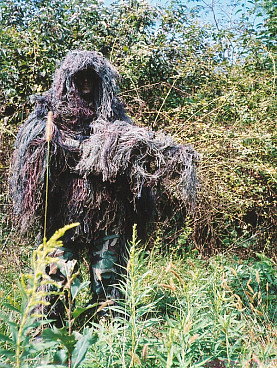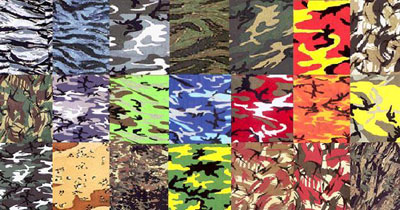Can You See Me Now? Good!
By WolverineAtWork
With special thanks to Robb/Scottsdale and Tyler Higgins
I believe that hunters have a
specific gene that accounts for many of the manias we suffer.
Whether it’s our gun obsession, hand or electronic calls
obsession or our obsession with tracking, stalking and taking
game animals, I think they can all be attributed to the “Hunter
gene”.
This may be the only explanation
as to why we spend millions of dollars a year on camouflage
clothing, guns and accessories. There’s just something
that tickles the hunter gene when we watch someone walk out
into the wild, sit down and disappear.
We all experienced it while watching
the movie adaptation of Tom Clancy’s book “Clear
and Present Danger” You all know the scene I’m talking
about. Each of us had one of those “I’ve gotta get
me one of those” moments when PFC Chavez popped out of
the brush in his ghillie suit a mere 10 feet from the men
looking for him.
| But
when we’re hunting predators, how much camo is too
much camo?
There has been a long running debate
over the ability of dogs (including foxes and coyotes)
to see color. Some hypothesize that dogs can only see
in black and white and shades of gray. If that is true,
then why isn’t all hunting camo black, white and
shades of gray?
The following is taken from an article
by Dr. Dana K. Vaughan, Ph.D., from the University of
Wisconsin at Oshkosh:
"Vision is just one of several
senses that dogs use to scan their world for important
information. Any visual scene has multiple aspects to
which dogs’ brains are sensitive: brightness, shape,
contrast, and motion are a few of these. But what about
color?
Many authorities have stated that
"dogs are colorblind", with the implication
that dogs perceive only black, white, and shades of
grey. In fact, this was not known for certain, but became
"folklore". Then, in the late 1980s, a definitive
set of experiments was done at the University of California,
Santa Barbara, by what may well be the world’s
foremost research program on comparative color vision.”
|
 |
|
Dr. Vaughan played a role in this well-known
study of color vision in dogs published by J. Neitz,
T. Geist, and G.S. Jacobs (1989), "Color vision
in the dog", Visual Neuroscience Vol. 3, pages
119-125. The complete article may be found by clicking
HERE.
As a result of this study, it was found
that dogs indeed lack the same color vision as humans.
Humans have three types of color receptors in their
eyes. Each color receptor picks up a small portion of
the visible light spectrum. Dogs were found to have
only two of these three types of color receptors in
their eyes. This means that while dogs do see color,
they are only able to differentiate a limited number
of colors. This is very similar to a human who is colorblind.
They are unable to differentiate between certain colors
or shades.
Dr. Vaughan summarized the findings
of the study by saying,
“These experiments showed that
dogs do see color, but in a more limited range than
that seen by normal humans, who see the rainbow of colors
described by "VIBGYOR": Violet, Indigo, Blue,
Green, Yellow, Orange, and Red (plus hundreds of variations
on these shades).
Instead, dogs see "VIBYYYR"
(Violet, Indigo, Blue, Yellow, Yellow, Yellow, and Red).
The colors Green, Yellow, and Orange all look alike
to dogs; but look different from Red and different from
the various Blues and Purples. Dogs are very good at
telling different shades of VIB apart. Finally, Blue-Green
looks White to dogs.”
Don't believe me? Click
on the button to view how dogs may view the world.

|
| I talked to Dr. Nietz who
conducted the study mentioned above. He was kind enough
to process a few pictures I supplied to illustrate how
a coyote may view camouflage patterns and colors. For
a more in depth study of colorblindness, there is a wealth
of information on Dr. Nietz site at http://www.mcw.edu/cellbio/colorvision |
|
This is a chart
of various camouflage patterns and colors.
|

Notice how the orange and red patterns
take on the same hue as the tan and brown colors in
the other patterns.
|
| In the pictures below, notice how
dramatically the bluejeans stand out. I also found in
interesting that the light green brush in the background
looks the same as the grass in the foreground in the filtered
picture. |
|
In these photos, note
how effective a simple 'poncho' made from leafy camo
blind material breaks up not only the color scheme but
the outline of the hunter as well
|
| So, What does this mean
to the average hunter? Probably not much since we tend
to buy what we feel looks "really cool" as much
as what is functional. What this does mean is that we
don't necessarily need to be so picky about the exact
color of our camo. It is also a great argument in favor
of using hunter orange to prevent hunting accidents. Since
dogs (and probably deer as well) can't distinguish between
orange, green and yellow, you can very easily get away
with blaze orange gear because it will blend into all
of the other greens and browns in the environment.
As Dr. Vaughan stated, there are more
elements to a dogs/coyotes ability to detect a hunter
in the wild. While color can play a factor, it is most
likely not the most critical factor in going unnoticed
in the field. We'll examine those other factors in other
articles.
In the meantime, stay upwind and don't
move.
Good Hunting!
|
|
|



